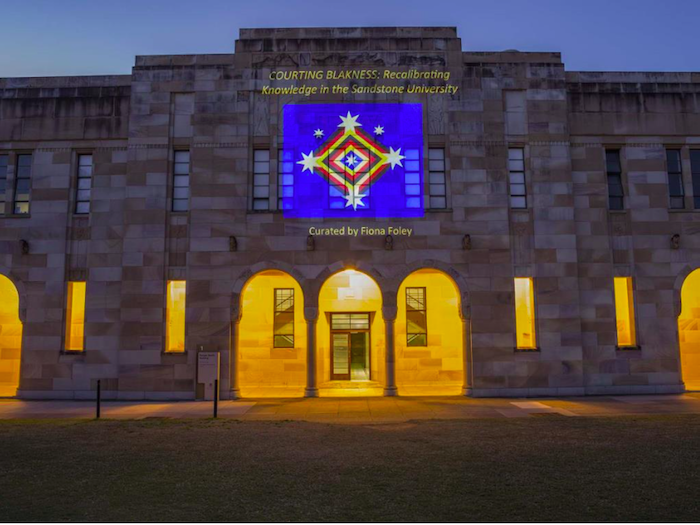AustLit
-
To coincide with the opening of the exhibition, a free public symposium took place at the St Lucia campus of The University of Queensland (UQ). This unique inter-disciplinary event brought together 32 artists, curators and academics from UQ and across Australia. Open to the public and free of charge, the event was held in two of UQ’s premier venues (Friday: Sir Llew Edwards Auditorium. Saturday: Advanced Engineering Building Auditorium) and attracted audiences working within education and cultural industries in Queensland and beyond.
-
A national symposium was held on the opening weekend of the public art installation at the University St Lucia Campus September 5-6, 2014. It built on the success of the international symposium Foley staged while Adjunct Professor at Griffith University in 2005.3 Fiona Foley’s professional expertise as an Adjunct Professor, with several decades of experience in the visual arts sector, guided the choice of artist and industry speakers. Fiona Nicoll’s extensive networks within the area of critical race and whiteness studies guided the selection of academic speakers working across a range of disciplines in humanities and social sciences including: art history, law, health, political science, sociology, cultural studies, architecture, history, philosophy, screen studies, creative writing and anthropology. The event was organised into eight panels—each responding to themes within the art and architecture of the Great Court and ideas sparked by one of the works in the public art installation. Approximately half the speakers contributed from an arts industry perspective4 while the other half reflected disciplinary and interdisciplinary academic perspectives. 5 Panels included strong representation by UQ academics working in law, architecture, politics, museum studies and art. With the exception of curator and academic Dr Ricardo Peach (from the Australia Council) all the panels were chaired by UQ academics with expertise in the relevant discussion themes.
-
Aunty Carol Currie welcomed participants to Country and Professor Carole Ferrier (EMSAH) introduced a curatorial statement by Fiona Foley. The keynote speech was delivered by Professor Larrisa Behrendt, a leading legal academic and chair of the Report of the Review of Higher Education Access and Outcomes for Aboriginal and Torres Strait Islander People (2012). Professor Behrendt’s keynote speech brought together colonial case law, journalism and academic literature on the shipwreck survival of Eliza Fraser in 1836. This created a strong site- based connection to themes from Fiona Foley’s research and art practice as a Badtjala woman from Fraser Island. Fiona Nicoll provided closing comments at the end of the symposium.
-
Courting Blakness turned the University of Queensland’s Great Court into a platform for a national symposium exploring the relationship between Aboriginal and Torres Strait Islander peoples and the University as a prestigious knowledge institution.
The Great Court reflects the University’s heritage, traditions and prestige by evoking the worldwide status and reputation of European institutions of higher learning. Stone friezes and figures depict narratives about the state’s historical progress alongside accomplished scholarly figures of European heritage. Yet the Great Court also stands on Aboriginal land and depicts Aboriginal heritage, with commissioned stone friezes representing Aboriginal people and their way of life. Much has changed since the University was founded in 1910, with questions about land, sovereignty and the representation of Aboriginal and Torres Strait Islander peoples recurring sources of controversy. As a leading knowledge institution, The University of Queensland is invariably bound with these and a range of related complex social and political questions which demand urgent attention.
Universities have traditionally been elite institutions, isolated and dissociated from the concerns of Indigenous people. Too often the contributions of generations of Aboriginal and Torres Strait Islander thinkers, activists and artists to ways of knowing, seeing and being human have been invisible or undervalued in our universities. Today, however, Indigenous knowledge and cultural industries are increasingly recognised as drivers of social change and innovation in the global university. Courting Blakness used original art to provide new ways of visualising the challenges of Indigenous belonging within universities and the wider community. It also provided a means of generating exchange between different cultural values and associated ways of seeing, knowing and being in the world.
The visual dialogue between contemporary Aboriginal art and the sandstone carvings in the Great Court invited members of the University and wider public to reflect on a number of questions:
What does it mean for universities and Aboriginal and Torres Strait Islander peoples to engage in mutually respectful and productive interactions? How can the burden of past relationships and particularly the failures of universities to engage respectfully, be overcome? Can art serve as a medium for understanding and further exploration of what it means for universities and Indigenous people to be in relationship in the global universities of the twenty first century? If so, how can this often untapped wealth be used to the benefit of all parties concerned? What is the role of art in contributing to definitions of and debates surrounding Indigenous Knowledge? How are debates about Indigenous knowledge and art tied to broader questions about law, history, politics, culture and society?
-
The symposium took place over two days at UQ’s St Lucia Campus
Friday 5 September 2014: Auditorium, Sir Llew Edwards Building auditorium (Building 14), 9.00am - 4.45pm.
Saturday 6 September 2014: GHD Auditorium, Advanced Engineering Building (Building 49), 9.00am - 4.15pm.
-
The symposium keynote speech was delivered by Professor Larissa Behrendt, Professor of Law and Director of Research at the Jumbunna Indigenous House of Learning at the University of Technology, Sydney.
Prof. Larissa Behrendt is a Eualeyai/Kamillaroi woman. She is the Professor of Law and Director of Research at the Jumbunna Indigenous House of Learning at the University of Technology, Sydney. She is admitted to the Supreme Court of the ACT and NSW as a barrister.
Larissa is a Land Commissioner at the Land and Environment Court and the Alternate Chair of the Serious Offenders Review Board, a member of the Academy of Social Sciences of Australia and a founding member of the Australian Academy of Law. She is the Chair of the Humanities and Creative Arts panel of the Australian Research Council College of Experts.
-
-
 This image has been sourced from the ABC.See full AustLit entry
This image has been sourced from the ABC.See full AustLit entryAcademic, lawyer and writer, Larissa Behrendt graduated from Harvard Law School with a doctorate in 1998. Her thesis was later published as the book Achieving Social Justice : Indigenous Rights and Australia's Future (2003). She is admitted to the Supreme Court of NSW and the ACT as a barrister.
Since 2001 Behrendt has been Professor of Law and Director of Research at the Jumbunna Indigenous House of Learning at the University of Technology, Sydney and has published extensively on property law, Indigenous rights, dispute resolution and Aboriginal women's issues.
You might be interested in...








